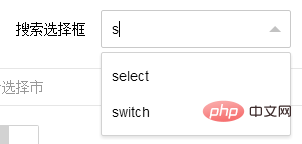

1. Ordinary input box input

<div class="layui-form-item">
<label class="layui-form-label"><span class="f_orange">*</span>字段编号</label>
<div class="layui-input-block width_250 pos-r">
<input type="text" class="layui-input" name="ColumnCode" lay-verify="required|inputLength_100" placeholder="" autocomplete="off">
<i class="icon_ca_layui"></i>
</div>
</div>2. Auto-complete input box
1. Make sure layui introduces the autoComplete plug-in.
2. Ensure that the initialization code runs in the callback function of layui.use.
3. Introduce baseUtility.js.

HTML
@* 备案网点 *@
<div class="layui-input-block" style="margin-top:5px; margin-left:320px;">
<label class="layui-form-label">备案网点</label>
<div class="layui-input-inline">
<input type="text" id="txtRegisterCompanyId_searchForm" lay-verify="required" style="width:200px;"
placeholder="请输入" data-provide="typeahead" class="layui-input" autocomplete="off">
<input type="hidden" name="RegisterCompanyId" id="hiddenRegisterCompanyId_searchForm" />
</div>
</div>js data source initialization
needs to be defined in the callback function of layui.use.
// 备案网点
siteUtility.GetAllSiteByKey("#txtRegisterCompanyId_searchForm", "#hiddenRegisterCompanyId_searchForm");One is the id of the input box, and the other is the id of the hidden field.
The GetAllSiteByKey public function has been defined in baseUtility.js.
Get its value
// 收集 查询表单数据
var serializeForm = $("#searchForm").formSerialize(true);This serialization method can get the id value of the hidden field.
Implementation method (reference)
/*
获取全部的网点
@param txtElementId 输入框Id
@param hiddenElementId 与输入框匹配的隐藏域Id
*/
GetAllSiteByKey: function (txtElementId, hiddenElementId) {
$(txtElementId).typeahead({
minLength: 0,
//items: 'all',
source: function (query, process) {
var xdata = [];
console.group('查询条件 = ' + query);
$.ajax({
type: "GET",
url: urlEnum.GetAllSiteByKey,
async: false,
data: { "q": query },
success: function (result) {
console.info('GetAllSiteByKey result');
console.info(result);
if (result != null && result != undefined) {
$.each(result.list, function (i, item) {
xdata.push({
id: item.value,
name: item.key,
obj: item
});
}); // end each
}
},
error: function (XMLHttpRequest, textStatus, errorThrown) {
// layer.msg("数据加载失败", { icon: 1 });
},
timeout: 5000
});
console.info('Auto 返回值:');
console.info(xdata);
// 如果 Auto 控件被用户置空则同时将隐藏域也置空
if ($(txtElementId).val() == "") {
$(hiddenElementId).val("");
}
console.groupEnd();
return process(xdata);
},
updater: function (item) {
console.info('updater = ' + item);
console.info(item);
$(hiddenElementId).val(item.id);
return item;
}
}); // end typeahead
}3. Assignment
Whether the input box is ordinary or automatically completed, you can directly assign a value
// 备案网点
$("#txtRegisterCompanyId_editForm").val(registerCompanyName);For more layui knowledge, please pay attention to the layui usage tutorial column.
The above is the detailed content of Introduction to commonly used input boxes in layui framework. For more information, please follow other related articles on the PHP Chinese website!
 vcruntime140.dll cannot be found and code execution cannot continue
vcruntime140.dll cannot be found and code execution cannot continue
 pr shortcut key
pr shortcut key
 How to dress up Douyin Xiaohuoren
How to dress up Douyin Xiaohuoren
 What does data intelligence mean?
What does data intelligence mean?
 parentnode usage
parentnode usage
 How to read data from excel file in python
How to read data from excel file in python
 What to do if the computer fakes death
What to do if the computer fakes death
 What to do if css cannot be loaded
What to do if css cannot be loaded
 What is the difference between JD International self-operated and JD self-operated
What is the difference between JD International self-operated and JD self-operated